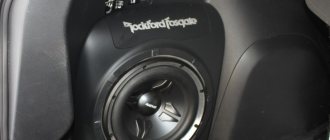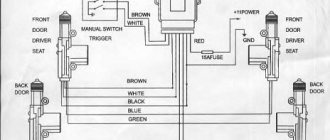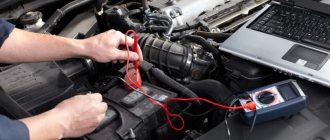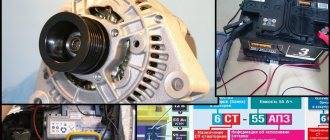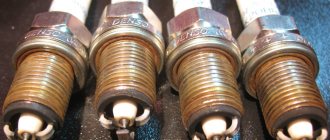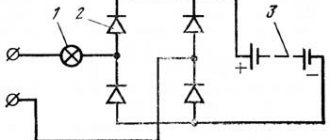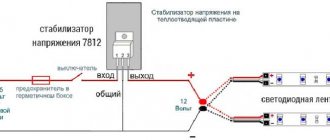Creating a professional audio system for a car is a true art.
Selecting the necessary equipment to create a balanced sound in a car has its own secrets and features. For example, the presence of stunning bass, which amazes with its depth and detail, lies in the presence of a special automotive capacitor, which can be purchased at an online auto parts store. It is the presence of this electronic component that reveals the potential of the amplifier and the subwoofer itself. In this publication, we will touch on all the nuances of choosing a car capacitor and methods for its correct installation. We will also not ignore its structure and the reasons why it may fail.
What is a capacitor used for?
A car audio system, which includes a separate amplifier and a powerful subwoofer, can draw very high current from the battery. The amount of current is so enormous that special thick wires are used to properly connect the amplifier. Sometimes the thickness of such a wire is greater than a human little finger. To provide a power supply system that can accumulate an electric charge of power for a long time, and release it at lightning speed at the right time, a subwoofer capacitor is used. I install this radio-electronic component to help the battery transfer current to the load very quickly. The capacitor helps especially strongly at peak moments in the reproduction of the most powerful low-frequency sections of musical compositions. The capacitor is also an excellent impulse noise filter. It reduces the noise level that inevitably occurs when starting powerful consumers in your car. An electrolytic capacitor for cars is an integral part of a complete car audio system with a subwoofer.
How does a subwoofer work without a capacitor?
A standard car battery is not capable of delivering huge current for a long time. Often its potential is not enough to power an amplifier and a large subwoofer. This is due to the fact that the car battery is designed to power the load for a long time in a uniform discharge mode with low currents. While a powerful car amplifier connected to a subwoofer requires a peak current that is close to the cold cranking current of the battery. Using subwoofer audio systems without using a special capacitor will result in improper battery operation. If we are talking about playing bass songs, then you are guaranteed to reduce the battery voltage from 12.7 volts to a threshold value of 9 volts. Such improper operation will have an unacceptable impact on the sound quality. We also note that the absence of a connected storage capacitor of a certain capacity leads to rapid wear of the battery. Active sulfation occurs at its plates, which leads to subsequent premature failure.
How to properly connect a capacitor?
The operation of a capacitor is based on the principle of storing electricity. To connect it correctly, a parallel circuit is used. A capacitor has two electrodes: the cathode is negative and the anode is positive. We connect the negative wire in parallel to the cathode of the capacitor and the negative terminal of the amplifier. If the capacitor contains an electronic circuit with an electronic analogue of ballast resistance, then the positive wire that comes from the battery is connected directly to the anode of the capacitor, and only after it there is a branch to the amplifier. Cheap capacitors, not equipped with a charging circuit, must be connected to the battery in series with a 12 volt incandescent light bulb. The thickest wires must be used. Their length should not exceed 30 cm. It is best to select such an arrangement of the capacitor relative to the amplifier in order to reduce the length of the wires to a minimum.
What is a capacitor?
A car capacitor is a device that helps store and quickly release electrical current. In a car, these properties are used for improved sound.
If we compare a capacitor for a car with a home one, then the principle of their operation is approximately the same: the device takes a certain amount of current from the network and at the speed it needs, and gives more, only with a car capacitor this process itself is a little more complicated, because it takes the current from the battery, which designed to solve other problems. As a result, the battery is not always able to supply the amplifier with the required amount of current. As a result, sound distortion occurs, which is associated with a decrease in output power and current starvation, which the autocapacitor is designed to eliminate.
Rules for installing a capacitor for a car.
In order to prevent a decrease in current amplitude due to the resistance of the connecting wires caused by the low resistance of the capacitor, it should be installed next to the amplifier. Remember that the distance between them should not exceed 60 cm: the smaller this segment, the better.
For example, a capacitor is often mounted on the amplifier itself, which is quite convenient and practical. However, there are other options for the location of these devices. For example, some car owners place the amplifier in the trunk, on its side wall, and the capacitor on the other. Although this looks beautiful, it is technically very impractical, because the distance between the devices is too large.
Features of installing a capacitor for a car.
The capacitor can be installed in a circuit of any power, even when operating one amplifier that is built into the head unit. However, if the capacitor is mounted in a sound system that is equipped with an external amplifier, then you need to start with the minimum possible power of the entire system - about 250-300 W.
True, it is not at all necessary to install this device only in an audio system that has a special “sound battery”. It’s just that such a “sound” battery is capable of not only quickly delivering current to the load, but also relieving the load on the vehicle’s on-board network quite well.
How to connect a car capacitor - video
The operation of powerful car subwoofers may be accompanied by problems associated with the high current consumption of these devices. You can notice this at low frequency peaks, when the subwoofer “chokes.”
This is explained by voltage drops at the subwoofer power input. An energy storage device, the role of which is played by the capacitance of a capacitor connected to the subwoofer power circuit, helps to correct the problem.
How to choose an amplifier
They differ in the number (1-, 2-, 3-, 4-, 5-, 6-channel) channels and class (AB and D). Class AB - analog devices, with high power ratings, but an insignificant efficiency factor that would correspond to the power reserve. Class D - digital devices with high efficiency rates and a large power reserve, but they cannot always boast of excellent quality.
1-channel devices Monoblocks, as they are also called, are used for subwoofers, as they operate at a low load (1-2 Ohms). They are most often presented in class D, since for a subwoofer it is not the quality that is important, but the power of the sound. They are equipped with a developed low-frequency crossover and an external volume control.
2-channel They are used to connect a pair of speakers or connect a subwoofer using a bridge connection. If the power allows, they can also be connected via a coil to a car amplifier channel. 3-channel Today they are used extremely rarely, since they have been supplanted by four-channel devices.
The third channel was used to connect a subwoofer. 4-channel The most popular and widespread all over the world. They are used to amplify power in various ways: connecting to four speakers, two speakers and one subwoofer, or two subwoofers. The versatility of their application determines their demand.
5-channel Used to increase the power of four channels of front and side acoustics and one subwoofer. This is an economical option that includes amplification of all components of the audio system in the car, and its compact dimensions can significantly save space. 6-channel They are used extremely rarely, as they are not in demand by ordinary consumers who prefer simpler car audio systems.
Choosing and buying amplifiers is only half the battle. It is very important to choose the right place to install it as they get hot. Therefore, it is necessary to provide them with natural ventilation. Some models have a built-in ventilation system and this is very convenient. Most often they are installed in the luggage compartment of a car, behind the back of the rear seat, under a seat, on the rear parcel shelf, on a false panel in the corner of the trunk.
It is very important to correctly configure the operation of the entire car audio system, consisting of a capacitor, amplifier, speakers, subwoofer and car radio. The specialist carrying out this work must have experience and knowledge of tuning, since the final sound quality depends on it. So, we came to the conclusion that an amplifier in a car is a necessary thing both for lovers of a calm and measured drive, and for connoisseurs of quality sound, volume and drive.
Why do you need a capacitor for a subwoofer?
An electrical capacitor is a two-pole device capable of accumulating, storing and releasing electrical charge. Structurally, it consists of two plates (plates) separated by a dielectric. The most important characteristic of a capacitor is its capacitance, which reflects the amount of energy that it can accumulate. The unit of measurement for capacitance is the farad. Of all types of capacitors, electrolytic capacitors have the highest capacity, as well as their further improved relatives - ionistors.
To understand why a capacitor is needed, let’s figure out what happens in the car’s electrical network when low-frequency car acoustics with a power of 1 kW or more are connected to it. A simple calculation shows that the current consumed by such devices reaches 100 amperes or more. The load is uneven, the maximums are reached at the moments of bass hits. The voltage drop when the car audio passes through the peak of the bass volume is caused by two factors:
- The presence of internal resistance of the battery, limiting its ability to quickly release current;
- The influence of the resistance of the connecting wires, causing a voltage drop.
The battery and capacitor are functionally similar. Both devices are capable of storing electrical energy and subsequently releasing it to the load. The capacitor does this much faster and more readily than the battery. This property underlies the idea of its application.
The capacitor is connected in parallel to the battery. With a sharp increase in current consumption, the voltage drop across the internal resistance of the battery increases and, accordingly, decreases at the output terminals. At this moment the capacitor comes into operation. It releases the accumulated energy, and thereby compensates for the drop in output power.
How to choose a capacitor
The required capacitor capacity depends on the power of the subwoofer. In order not to go into complex calculations, you can use a simple rule of thumb: for 1 kW of power, a capacitance of 1 farad is required. Exceeding this ratio is only beneficial. Therefore, the most common high-capacity capacitor on sale, 1 farad, can also be used for subwoofers with a power of less than 1 kW. The operating voltage of the capacitor must be at least 14 - 18 volts. Some models are equipped with a digital voltmeter indicator. This creates additional ease of use, and electronics that control the charge of the capacitor make this procedure easier.
general information
The best capacitors for acoustics
So why do you need a capacitor? As you know, the price for it is not small and not all motorists, even lovers of good sound, want to cut their budget once again. On the other hand, every music lover sooner or later acquires a powerful speaker system or brings it to perfection. This is very good, but the more powerful the system, the more energy you give it.
A capacitor in acoustics (see) is a component that serves as an additional power source for an amplifier. This element is very important and
- Thanks to him, the amplifier always receives energy when absolutely necessary. The fact is that in acoustics there is such a thing as linear drop. This happens at times of peak load on the subwoofer and amplifier. At this moment, the battery is not able to provide them with the required amount of energy and then the capacitor comes to the rescue;
- It's not just about powerful bass drivers. Almost all modern subwoofers are capable of consuming significant current during short-term peaks. No matter how powerful the battery is, it is clear that it will not cope with this task.
- In addition, the battery and generator de-energize the air conditioner in the summer, which takes up to 30 percent of valuable energy.
Read more: What is a CVT transmission review and owner reviews
So, the capacitor is able to solve the problem with dips, since it is a high-capacity electrolytic device, the connection of which occurs in parallel with the power supply circuit of the amplifier. The capacitor has practically no resistance, or rather, it is so small that the current is given to the amplifier instantly, thereby eliminating the occurrence of dips. Then, with the same speed, the capacitor is charged again and is ready to give out the next portion of beneficial current for the amplifier.
How to connect a capacitor to a subwoofer
Installing a capacitor is not a complex procedure, but when performing it you need to be careful and follow some rules:
- To avoid a noticeable voltage drop, the wires connecting the capacitor and the amplifier should not be longer than 50 cm. For the same reason, the cross-section of the wires must be chosen large enough;
- Polarity must be observed. The positive wire from the battery is connected to the positive power terminal of the subwoofer amplifier and to the capacitor terminal marked with a “+” sign. The capacitor terminal marked “-” is connected to the car body and to the negative terminal of the amplifier power supply. If the amplifier was previously connected to ground, the negative terminal of the capacitor can be clamped with the same nut, while maintaining the length of the wires from the capacitor to the amplifier within the specified limits of 50 cm;
- When connecting a capacitor to an amplifier, it is better to use standard clamps to connect wires to its terminals. If they are not provided, you can use soldering. Twisted connections should be avoided as significant current flows through the capacitor.
Figure 1 illustrates the connection of a capacitor to a subwoofer.
How to charge a capacitor for a subwoofer
To connect to the car's electrical network, an already charged car capacitor should be used. The need to perform this action is explained by the properties of the capacitor, which were mentioned above. The capacitor charges as quickly as it discharges. Therefore, at the moment the discharged capacitor is turned on, the current load will be too high.
If the purchased subwoofer capacitor is equipped with electronics that control the charging current, you don’t have to worry; feel free to connect it to the power circuits. Otherwise, the capacitor should be charged before connection, limiting the current. It is convenient to use an ordinary car light bulb for this, turning it on against the power supply circuit. Figure 2 shows how to properly charge large capacitors.
At the moment of switching on, the lamp will light up at full intensity. The maximum current surge will be limited by the power of the lamp and will be equal to its rated current. Further, during the charging process, the glow of the lamp will weaken. At the end of the charging process, the lamp will go out. After this, you need to disconnect the capacitor from the charging circuit. Then you can connect the charged capacitor to the amplifier's power supply circuit.
If after reading the article you still have questions about connection, we recommend that you read the article “How to connect an amplifier in a car.”
Brief overview of capacitor models
From the information provided, it is clear that capacitors differ in capacity, set of functions, and equipment. Accordingly, the price category of devices ranges from about forty dollars per unit of goods and can reach three hundred dollars per device.
Autofun CAP-10 is one of the simplest and most affordable devices. The cost is about forty dollars, the device capacity is 1 farad, the operating temperature is up to 95 degrees. It is in demand among buyers due to its attractive price.
Autofun CAP-10
Hollywood brand capacitors are also in demand among customers. The price range of models of this brand is from fifty dollars to two hundred per unit, depending on the capacity of the device and additional functions.
Hollywood brand capacitor
The Signat ECC1 is a small device, although it has attractive characteristics. Capacity - 1 farad, price about two hundred and fifty conventional units.
Signat
The Brax IPC is a reasonable power capacitor that costs over three hundred dollars. This device has super-powerful electrical characteristics; the operating principle is based on automation. There is practically no internal resistance in the capacitor.
Brax IPC
And one more rule. For devices, a characteristic feature is the correspondence between the price and quality of the device. The more expensive the product you purchase, the more reliable it will be in operation.
Subwoofer capacitors are very easy to install, so you don’t need the help of a specialist. You can handle this task yourself by following the simple instructions that come with the device.
Autofun CAP-10 is one of the simplest and most affordable devices. The cost is about forty dollars, the device capacity is 1 farad, the operating temperature is up to 95 degrees. It is in demand among buyers due to its attractive price.
The Signat ECC1 is a small device, although it has attractive characteristics. Capacity - 1 farad, price about two hundred and fifty conventional units.
The Brax IPC is a reasonable power capacitor that costs over three hundred dollars. This device has super-powerful electrical characteristics; the operating principle is based on automation. There is practically no internal resistance in the capacitor.
The best prices and conditions for the purchase of new cars
Many car enthusiasts who have installed a subwoofer in their car are seriously puzzled by the issue of a capacitor for a subwoofer. It would be more correct to say a capacitor for an audio system, but since such a concept as a capacitor for a subwoofer has taken root, we will use it.
So the main question is - is it necessary or not? It’s definitely needed, but is it worth spending money on it, because this thing is quite expensive. Unfortunately, there is no clear answer to this question even among professionals. Many people believe that it is better to spend money on power wires with a larger cross-section and a more capacious battery.
And again BUT appears. Power wires and a powerful battery can only fight up to a certain limit, and beyond that...the capacitor comes into play.
“The amplifier is connected to a powerful power source - a generator and a battery. Connected with proportionally powerful wires that would make an electric welder jealous. What more could an amplifier want? And he desires, even demands. It requires not only the amount of energy, but also the speed at which it enters its aluminum belly.
After all, he has to amplify not a smooth hum, but a musical signal, pulsed in nature. And so, when that same cherished and dramatic explosive chord came to the entrance, the device discovered that lighter gasoline, even when there is a lot of it, cannot burn faster than a certain speed. A powerful current pulse, which at this moment passes through the entire power circuit, melts and is smeared by the voltage drop across the wires, terminals, connectors, and is lost at the internal resistance of the battery.
Read more: Orion car radios, let's look at some models
Life, of course, is not a magazine; a lot of operational issues come into play in it, for example, a generator. There have been cases where, after installing a subwoofer, the generator failed, and the reason is most likely not only due to the increased load. The reason is constant voltage drops, when the entire electrical system fluctuates in time with the dynamic load of the subwoofer. I won’t even talk about drained batteries when listening to music when the car is not running.
Let's return to the capacitor for the subwoofer. From the stories and descriptions it is easy to understand what he is like, but it is still better to see once than to hear a hundred times.
The circuit uses an 8 farad capacitor and a 12-inch DLS subwoofer plus a three-band front. So the peak current consumption reached 28A. Which is equal to 390W! (in the case of direct current, simply multiply volts by amperes) In this case, the voltage drop is visible on the instruments. In reality, the drawdown should be greater, because devices simply do not have time to track sudden changes in voltage. But everything is quite smooth. so draw your own conclusions.
Despite the English notations, everything is quite clear. It is only worth noting that to improve sound quality, it is worth connecting the mass going to the capacitor (as well as ““) with a wire, and not using the car body.
In recent years, it is increasingly possible to find subwoofer drives that use capacitors (from the Latin condense). If previously such a filter for a subwoofer was found only in top-level systems, today they can increasingly be found in budget installation options. Let's try to figure out on our website why a condenser is needed in a car audio system. A modern active subwoofer can cause short-term problems while playing music. peaks consume significant current.
Even the most powerful car batteries cannot provide such current power. Without the use of a condenser, at these moments there are dips in the operation of the subwoofer, which significantly deteriorates the sound quality. It is to solve the problem of voltage accumulation that capacitors are used.
The main purpose of this component is to accumulate charge, which, if necessary, is given to the amplifier for the subwoofer. After the discharge is released, the capacitor is charged again for a new subwoofer bass. All this happens in a split second, which allows for high-quality sound.
Even in budget installations with a subwoofer, the sound quality improves dramatically. The unpleasant, indistinct muttering of the subwoofer that appears during voltage dips disappears.
Electrical diagram for connecting a capacitor to a subwoofer
The electrolytic capacitor is connected in parallel to the subwoofer and the battery, the capacitance of the capacitor is selected experimentally to be no less than 60,000-65,000 uF.
Appearance of one of the brands of capacitors
Now let's look at capacitor models that we think are interesting and that are recommended to be installed with a subwoofer. Let's start with the most expensive and best, according to experts. Let us note right away that all popular models are not included in this article (detailed reviews of capacitors can be read in other articles on our website).
Brax IPC
Capacitor costing 300 US dollars. The model name IPC stands for “intelligent power capacitor.” It has the following features:
- The user will find in this model a luxurious, superbly finished, clearly thought out device with the highest electrical performance;
- The length of the capacitor body is 280 mm, and the diameter is 75 mm;
- The operating principle is based on automation, which will provide charging with a normalized current and protect the acoustics from overvoltage;
- The Brax capacitor operates at 17.5 V, if connected incorrectly, automatically connected to the power network and disconnected;
- Provides continuous indication of voltage at the amplifier terminals (see);
- The capacitor is made in a stylish, beautiful case with a transparent head, in the center of which a 3-charge digital indicator is displayed. This indicator becomes active as soon as it senses the slightest voltage ripple on the amplifier and shows a voltage of up to 0.1 V;
- The capacitor readings are not carried out by continuous blinking, as on some cheap models, but are averaged with a time constant of about 1.5 s;
- For rapid fluctuations, the answer is another indicator, operating on 2 LEDs. If one of them or two blinks at once, this indicates short-term voltage ripples;
- There is also a third indicator called CPS. It is needed to report danger: if it lights up red, the polarity is reversed; if it lights up yellow, the overvoltage protection has tripped.
In a word, this is a gorgeous device that we recommend everyone buy. In addition to purely intellectual capabilities, this capacitor has virtually no internal resistance and it passes through at a record low.
An excellent electronic capacitor with declared internal resistance characteristics. The approximate price of the device is $250. It has the following features:
- Stated internal resistance characteristics: 1.8 mOhm/120 Hz and 1 mOhm/20 kHz;
- The advantages of this capacitor will be fully manifested in conjunction with a high-quality amplifier (where power supplies, as a rule, operate at a higher frequency);
- The head of the device is filled with electronics, which ensures smooth charging in 10 seconds;
- You can know that charging is in progress by the blinking indicators;
- If the voltage in the network crosses the value limit of 15.5 V, the protection is triggered immediately. If the voltage drops (11 V), the capacitor turns off and goes into hibernation.
Signat ECC1
Automotive capacitor for $230. Extremely compact, despite its record performance. Features:
- The model is made in a traditional dark blue case, with a diameter of 70 mm (the usual size of capacitors in other models is 75 mm);
- The top or head of the device, as is commonly seen on high-end capacitors, houses the electronics. It is able to provide a fully automated charging procedure in just 1 minute. We are talking about a current of 500 mA;
- You can find out about the charging process by the LEDs that light up. There are 5 of them of different colors, from red to green, and they glow alternately. You should know that when the last fifth indicator lights up, this indicates that the capacitor is fully charged.
- Voltage fluctuations are controlled by the same LEDs that monitor the charging of the device. When the voltage fluctuates, they go out one by one;
- There are two more separate LEDs. One of them is designed to indicate whether the connection to the power circuit has occurred, and the other reacts if there is an error in the polarity connection.
- The ECC1 signal is designed so that the operation of the device can be observed from two positions: either through a transparent wall or from above, where there are translucent windows;
Brax IPC
Additional benefits of installing capacitors in cars
In addition to solving problems with the operation of the subwoofer, a capacitor connected to the car network has a positive effect on the operating mode of electrical equipment as a whole. This manifests itself as follows:
The capacitor is installed, and you notice that your subwoofer is starting to play more interestingly. But if you try a little, you can make it play even better, we suggest you read the article “How to set up a subwoofer.”
